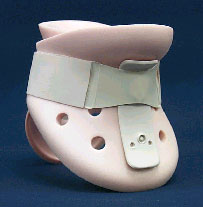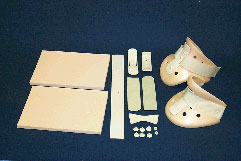| Concept |
|
|
|
|
|
|
|
|
|
|
|
|
| Stabilization of
the cervical spine region is not a new concept, but it has been revolutionized
by product developments of the Philadelphia Cervical Collar Company. Prior
to 1971, there were only two types of cervical collars on the market, the
soft-foam collar, which offered little or no support and the hard-rigid
metal collar, which was uncomfortable to wear and made X-rays impossible
without removal. The Philadelphia Cervical Collar was specifically designed
to overcome problems inherent with competitive cervical collars. |
|
|
|
 |
|
|
|
|
|
|
|
|
|
|
| The purpose of
cervical collar orthoses is to alleviate instability of a compromised cervical
spine, while being patient-friendly, lightweight and economical. Unfortunately,
many products cannot satisfy the above criteria due to poor product design,
inefficient manufacturing capabilities or lack of knowledge of cervical
spine physiology. The Philadelphia Cervical Collar Company was created to
address the medical community's need for a lightweight, affordable, high-quality
cervical collar. |
|
|
|
|
|
|
|
|
|
|
|
|
|
|
|
|
|
|
| It was by accident
that the idea for the Philadelphia Cervical Collar was born. One day Frank
Gramaglia was called into the office of a nationally recognized orthopedic
surgeon to discuss a hip device. While Mr. Gramaglia was waiting, he noticed
literature for Plastazote foam and began to read the technical and instructional
information. After the meeting concluded, Frank brought the brochure to
his family's orthopedic shop to show his uncle, Anthony Calabrese. |
|
 |
|
|
|
|
|
|
|
|
|
| With two sheets
of foam, they experimented and incorporated it into a variety of different
products one of which was a cervical collar. Anthony made the first collar
from a plaster impression of Frank's neck, but they noticed that the product,
while stabilizing his cervical region, did not support Frank's brother,
Joseph. They decided to alter the collar into two parts, a front half and
a back half and increased the level of immobilization features. This allowed
the collar to immobilize a wider range of neck circumferences, thereby transforming
the product from a custom-made product into a commercially acceptable off-the-shelf
product. |
|
|
|
|
|
|
| Mr. Gramaglia had
a patient at Jefferson Hospital who had a difficult time sleeping in a metal
two poster brace. The orthopedic surgeon agreed to use the new cervical
collar on the patient. They discovered that the product provided the necessary
cervical immobilization while increasing patient comfort and compliance. |
|
|
|
|
|
|
| Soon after, the
Philadelphia Cervical Collar became the recognized gold standard in cervical
spine immobilization by orthopedic and neurological surgeons throughout
the world. |



